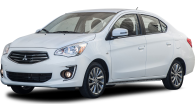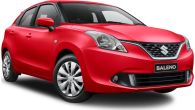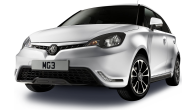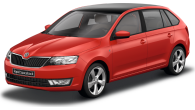Maligned by motoring journalists and car enthusiasts alike, the MG3 proved once again that critical success isn't necessary to be a best seller. As they say, there's no such thing as bad press.
The small car was the SAIC-owned MG brand's Hyundai Excel moment. The 2011 MG3 became a price leader that put the brand on the map in Australia finding plenty of homes with first car buyers and rental fleet managers alike.
Here’s a stat that might surprise you: over 15,000 of the small cars sold locally - almost four times as many MG3s found homes in Australia last year than in the much larger UK market.
The new 2024 MG3 is looking to build on that success and follow in the footsteps of the critically acclaimed MG4 electric car which is selling strongly.
This third-gen MG3 (not everyone knows about the Rover Streetwise-based MG3 SW sold in China) brings a fresh platform, updated safety features and even a fuel-sipping hybrid powertrain.
All things that should help it steal sales from now rather expensive rivals, including the Toyota Yaris, Mazda 2, Suzuki Swift and even Volkswagen Polo, if it’s good enough.
For all the new MG3's added features and striking looks, it's a nameplate that predominantly sold on price and value over buyer interest. We've driven the entry-level Excite trim fitted with the 'Hybrid+' powertrain to see if the makeover has been a success.
MG MG3 Hybrid+ 2024: Excite
| Engine Type | Inline 4, 1.5L |
|---|---|
| Fuel Type | Premium Unleaded/Electric |
| Fuel Efficiency | 4.3L/100km (combined) |
| Seating | 5 |
| Price From | $27,990 |
Price and features – Does it represent good value for the price? What features does it come with? 8/10
MG offers two trims – Excite entry level and Essence range topper – and a pair of powertrains. They're difficult to tell apart in the flesh using the same exterior garnishes, matching mirror caps and identical wheels.
Start price is up a whole lot from the previous model and it is no longer drive-away. It pushes the current run-out $18,990 drive-away price up to $23,990 before on-road costs.
The Hybrid+ powertrain is an expensive option adding $4000 to the price.

You do get a lot more for your money, though. A set of 16-inch alloy wheels (no hubcaps here), a CVT automatic, a 10.25-inch touchscreen, a digital driver’s display, cloth upholstery, manual seat adjust and polyurethane-appointed steering wheel feature on the Excite.
Outside, you can only tell the difference between our base car and the $2000 more expensive Essence by the LED headlights and a sunroof, otherwise they’re visually very similar.
The Essence gets rain-sensing wipers, white artificial leather upholstery on the seats, leather-wrapped steering wheel, a 360-degree camera and remote smartphone control of the air conditioning and heating.

The Essence adds a few goodies but it's not a transformative jump. The Excite feels like all you need.
Growing more expensive than the Kia Picanto (GT-Line at $23,490 drive-away) is probably no bad thing either, as the Korean car is significantly smaller than the MG3. Pricing for the new Suzuki Swift is set to be revealed shortly, but it is likely to undercut the MG3, too.
The MG3's powerful hybrid allows it to compete with the Toyota Yaris Ascent Sport hybrid on more level terms... but it needs to because its price is only $501 shy of the Toyota.
Design – Is there anything interesting about its design? 7/10
For all the flack Chinese carmakers have taken for copying others homework, the new MG3 is refreshingly original from the outside.
Not to say it's a beautiful car: that front overhang is a little too long and we think the wheel design is a little chintzy but at least the new MG3 feels differentiated in the class.
It has a distinctive face and confident character lines down its flanks while the Brighton blue hero colour (pictured) is eye-catching – we'd skip the '90s inspired Pastel yellow hue, though.
Inside, a hexagonal steering wheel borrowed from the MG4 is complemented by confident horizontal volumes. The MG3's interior is largely uncluttered by buttons and, in a nod to the previous MG3, there's an off-axis Tartan flourish ahead of driver and passenger.
MG has placed a piece of soft vinyl prominently, situated just in front of the high resolution 10.25-inch touchscreen to give the cabin a tactility lift. The rest of the materials are typically plasticky yet there is a pleasant grain that takes some of the shine away and restore a more quality feel.
Practicality – How practical is its space and tech inside? 7/10
The brand has clearly worked on the functionality of its multimedia system since debuting in the MG4. It looks familiar but the touchscreen is more responsive and there are intuitive shortcut buttons for the screen-based HVAC controls.
Apple CarPlay and Android Auto remains wired via a regular USB port, unfortunately, and there is no wireless charging on either grade. A USB-C port and 12-volt socket are present for extra cabled charging.
The digital driver's display has adequate functionality and includes an instant tyre pressure monitoring display – a key safety feature.
The steering wheel controls have been updated with clearer labelling. The right side controls the media volume and driver's display and left panel manages cruise control and driver assistance features.
MG's Excite doesn't feel like a de-contented base model with quite agreeable cloth upholstery, The driver's seat offers six-way manual adjustment and is comfortable with good back support.
The driving position was good for me, however, without telescopic steering wheel adjust you may find it more difficult to find an ideal spot.
There are two cup holders in the centre console ahead of the rotary gear selector (base petrols get a normal shifter). A further tray for phone and wallet storage sits ahead and the door bins are generous for a small car.
Not to be taken for granted in the class is a padded centre armrest with covered storage for valuables.
Measuring just over 4.1 metres long, don't expect palatial back seat space but the MG3 is certainly passable for a city car. At 188cm I could just squeeze in behind my driving position and soft-backed chairs aid comfort.
There are even adjustable vents and a USB port for rear passengers. Unfortunately, the window switches are not all auto up and down.
The standard trio of top tether anchors and pair of ISOFIX anchors for outboard seats are present for child capsules and chairs.

It's in the boot where the MG3's cost cutting becomes most obvious. The floor material is flimsy, there's only one shopping back hook and the back rest is a rare case of non split-folding. It is an awkward task flicking the seat down as you need two hands to unlatch the rest.
At 293 litres the boot is generous in size, though, and petrol models feature a space-saver spare. The hybrid places its 12-volt battery in the cavity under the floor.
Under the bonnet – What are the key stats for its motor? 7/10
The 1.5-litre petrol four-cylinder is a new direct-injected item that produces less power (81kW at 6000 rpm – down a kilowatt) and torque (142Nm at 4500 rpm lower by 8Nm) than the item it replaces.
It now drives the front wheels via a CVT automatic instead of a four-speed slushbox.
The 'Hybrid+' option is much more interesting. It uses a different 1.5-litre petrol engine running in Atkinson cycle and, unlike the Suzuki Swift, is a proper system.

MG's hybrid is different to Toyota's 'e-CVT' transaxle set up, the brand calls its transmission a three-speed automatic. We have not seen diagrams but in operation it feels similar to GWM Haval's 'Dedicated Hybrid Transmission' solution in the Jolion.
That means impressive peak outputs of 155kW and around 420Nm but those figures only occur at very specific times – peak torque, for example, is only delivered at 50km/h in second gear when the 1.83kWh battery is suitably charged.
The resulting 0-100km/h sprint claim is 8.0 seconds for the MG3 hybrid.
Efficiency – What is its driving range? What is its charging time? 8/10
The petrol-only model's rated fuel consumption falls from 6.7L/100km to 6.0L/100km. It requires 91 RON unleaded and is rated to Euro 5 standards.
The hybrid scores 4.3L/100km in the ADR combined consumption. That's not as good as a Toyota Yaris hybrid (3.3L/100km) but the trade-off is way more grunt.
From the 36L fuel tank – that requires 95 RON unleaded – you can expect over 1000km total driving range.
In reality, we managed to come close to the figure on a 200km country and suburban loop with the trip computer reading 4.8L/100km. A 50km suburban commute was better returning 3.4L/100km.

The MG3's hybrid system can be a little fickle, though.
For the first 10 minutes of driving the petrol engine has to rev at 1500-2000rpm to charge the battery. We saw consumption climb to 10L/100km when the car was cold.
It also proved more sensitive to driving style than Toyota's hybrids which seem to be extremely efficient no matter how heavy your right foot is.
Driving – What's it like to drive? 6/10
The MG3 continues the theme on the road. An impressive effort at first glance – certainly enough to impress on a test drive – yet spend an extended period behind the wheel and some cracks begin to show.
The steering is light and easy in town with two and a half turns lock-to-lock and a tight turning circle. There is good visibility out and driver aids are mostly unobtrusive.
Borrowing from its EV stablemates, the MG3 has three levels of regenerative braking. It defaults to '2', the mid setting, which we found a bit too bitey – '3' is way too much. The lowest level is relatively natural, though no setting is a one-pedal mode.
Its ride is really good for the class being more compliant than a Kia Picanto. The front end is especially absorbent though the rear can be a little abrupt on sharp bumps – this is common on small cars with front struts and rear torsion beams.

The MG3's hybrid powertrain is smooth and slick around in the city with a reassuring brake pedal.
And while the torque figure doesn't always ring true when the battery is discharged, with it juiced up the MG3 is rapid between 35-60km/h. The fairly light 1298kg kerb weight keeps it feeling quite peppy.
Not all is perfect, though, and the MG3 isn't so talented on the open road.
This little car is very noisy on coarse chip road surfaces at above 70km/h and there are pronounced steps in the power delivery at higher speeds, making it hard to trust the MG3 when merging into gaps.

Be wary of the speedometer as well – it is more accurate than most cars with almost no error. Our GPS lined up exactly at 100km/h.
The MG3's steering has poor on-centre feel at pace. There is a lot of body lean to the chassis and it reacts nervously to small corrective inputs in crosswinds and cambers.
Wrapped around its 16-inch alloys are 195/55 R16 sized Kumho Solus HS63 tyres which are reasonable but nothing special.
A brief test drive could convince you the MG3 has moved ahead of the Suzuki Swift, Mazda2 and even Volkswagen Polo. A longer drive confirms that, though the MG3 has come a long way, the more expensive nameplates in the class are more polished all-rounders.
Warranty & Safety Rating
Safety – What safety equipment is fitted? What is its safety rating? 6/10
The MG3 has yet to be rated by independent safety testing bodies, including ANCAP.
The MG3 follows the MG5 sedan which was awarded a zero-star rating by ANCAP. Not only did it lack safety features, it scored zero in various adult occupant protection criteria including frontal offset, full width, far-side and whiplash protection.
Unlike the 5 the MG3 is a key vehicle in Europe and the United Kingdom so a high rating in crash testing is important.
All MG3s are fitted with adaptive cruise control, autonomous emergency braking, speed sign detection, lane-keep assist and lane-departure warning. The Essence gets blind-spot detection and rear cross-traffic alert on top.
The systems aren't intrusive in town but the lane-trace assist and adaptive cruise control are not great. The lane-assist bounces the MG3 between lane markings and the adaptive cruise slows down too early and quickly when approaching another vehicle.
The MG3 features six airbags: front driver and passenger, curtain and side though there is no centre airbag.
Ownership – What warranty is offered? What are its service intervals? What are its running costs? 8/10
MG's seven-year/unlimited kilometre warranty is equal best-in-class with the Kia Picanto.

The brand has yet to detail service pricing and scheduling for the new light car.
Verdict
There is no doubt that the new MG3 is better than the car it supersedes – that tends to happen when you replace something that's 13-years old. It drives smoothly enough, has a frugal hybrid powertrain and good levels of safety equipment. Interior space is adequate and there are some genuinely nice touches like the comfortable seats and cabin design.
But that doesn't mean the new MG3 is better than the Toyota Yaris, Mazda2, Suzuki Swift or Volkswagen Polo. Those established rivals are more consistent, have greater breadth of ability and now really aren't that much dearer than MG's entry-level city car.
That said, the MG3 is still more affordable than most and transformed in driving experience. It is, therefore, worth putting on your small car short list, if no longer buy-without-thinking cheap. We applaud MG improving its products based on feedback and hope the much-improved MG3 finds buyers. Expect a comparison test with key rivals soon for a definitive verdict.
Pricing Guides

Range and Specs
| Vehicle | Specs | Price* |
|---|---|---|
| Essence | 1.5L, Premium Unleaded/Electric, 3 SPEED AUTOMATIC | $29,990 |
| Excite | 1.5L, Premium Unleaded/Electric, 3 SPEED AUTOMATIC | $27,990 |































































.jpg)
.jpg)
.jpg)
.jpg)
.jpg)

.jpg)
.jpg)

Comments